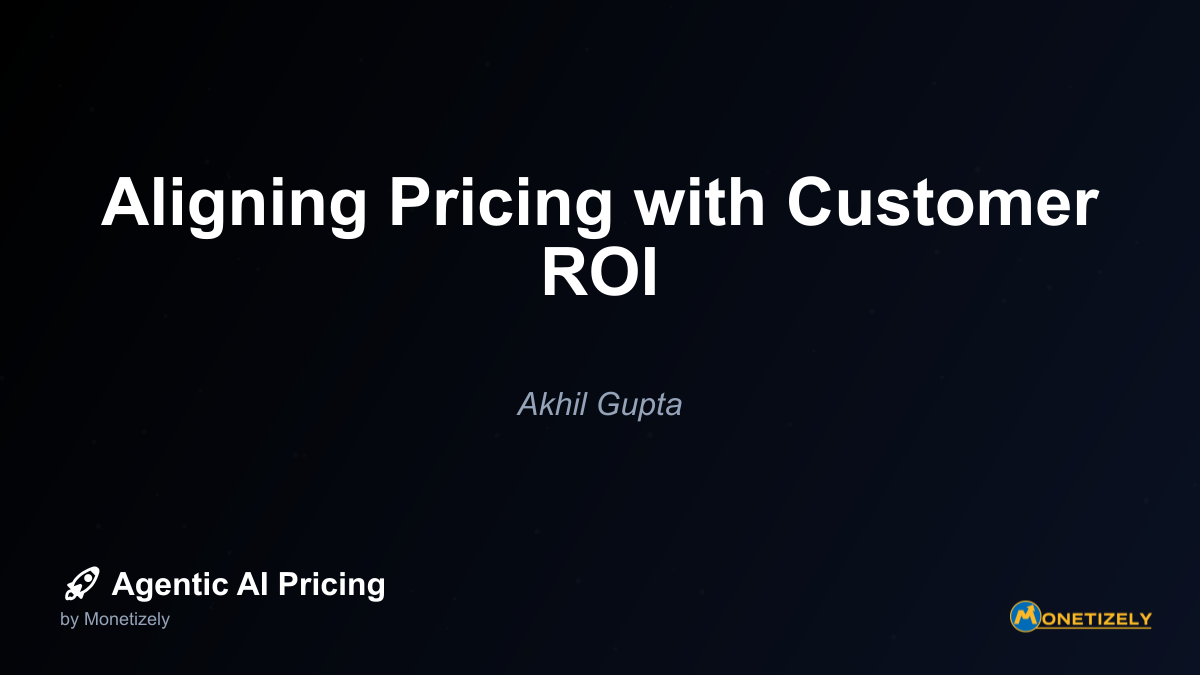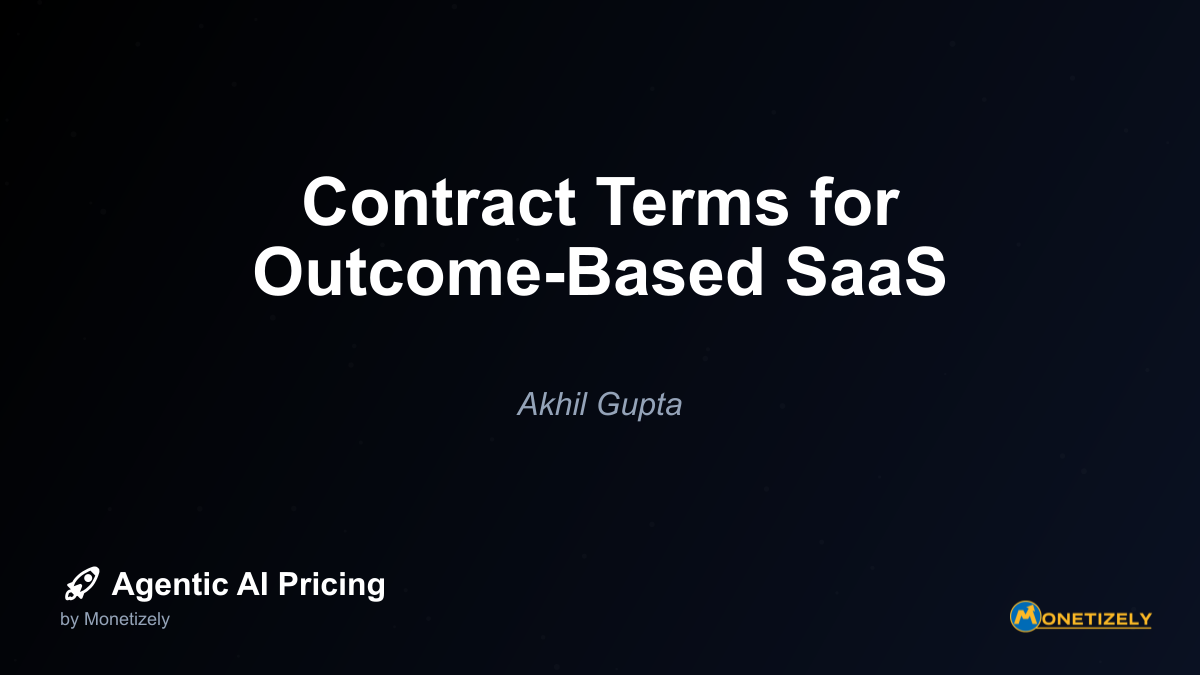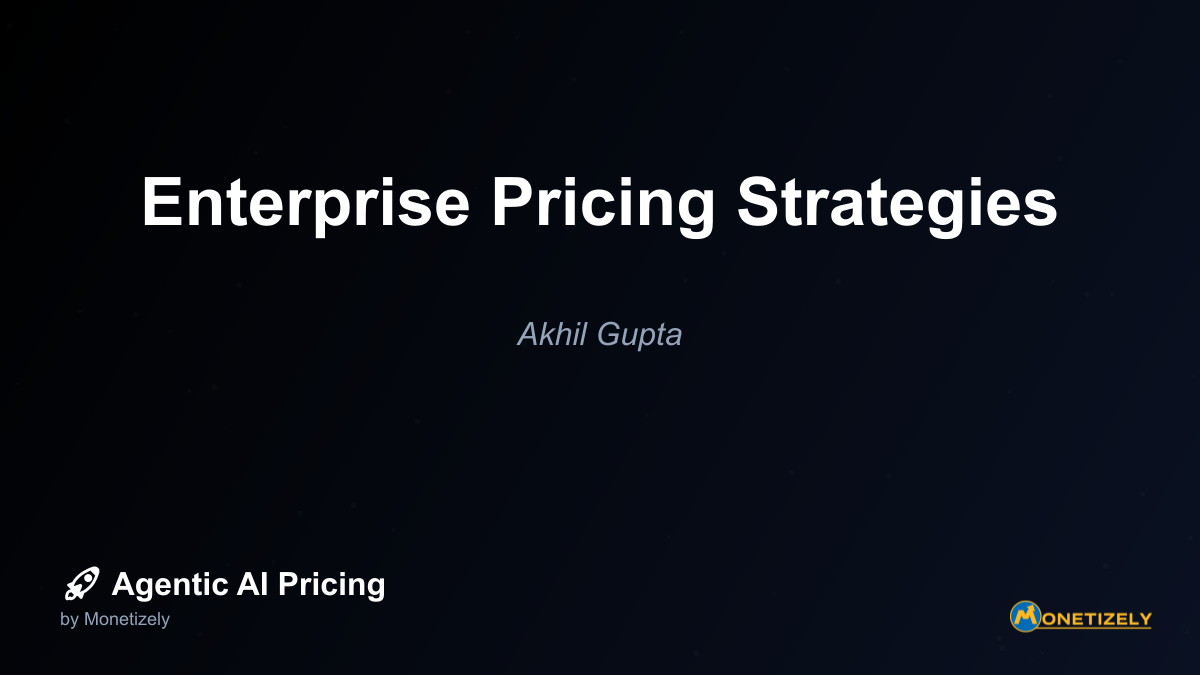· Akhil Gupta · Pricing Agentic SaaS Products · 8 min read
Aligning Pricing with Customer ROI
AI and SaaS Pricing Masterclass
Learn the art of strategic pricing directly from industry experts. Our comprehensive course provides frameworks and methodologies for optimizing your pricing strategy in the evolving AI landscape. Earn a professional certification that can be imported directly to your LinkedIn profile.

Implementing Value-Based Pricing for Agentic AI
Value-based pricing represents the purest form of ROI alignment. Rather than charging for the technology itself, vendors set prices based on a portion of the measurable value delivered to customers. This approach requires several implementation steps:
1. Identify and Quantify Value Metrics
The foundation of ROI-aligned pricing is identifying specific, measurable value metrics relevant to your customer’s business. These metrics vary by industry and use case, but might include:
- Cost Reduction: Labor savings, reduced error rates, improved resource utilization
- Revenue Enhancement: Conversion rate improvements, customer lifetime value increases, market share gains
- Risk Mitigation: Compliance violation reductions, fraud prevention, security incident decreases
- Time Acceleration: Faster time-to-market, reduced cycle times, quicker decision-making
For each metric, establish clear baseline measurements and develop methodologies for ongoing tracking. This quantification becomes the basis for your pricing structure.
2. Build Value Assessment Tools
Develop tools and frameworks that help prospects understand the potential ROI before purchase. These might include:
- ROI calculators that estimate value based on customer-specific inputs
- Case studies with detailed ROI analysis from similar customers
- Value assessment workshops that guide prospects through quantification
- Benchmarking data showing typical results for different customer segments
These tools serve dual purposes: helping customers justify the investment internally while setting realistic expectations for the value they’ll receive.
3. Structure the Commercial Agreement
With value metrics established, the commercial agreement can take several forms:
Shared Success Models: The vendor receives a percentage of measurable gains (e.g., 20% of cost savings or 10% of revenue increases).
Guaranteed Outcomes: Fixed fee with partial refunds if agreed-upon metrics aren’t achieved.
Tiered Value Sharing: Pricing tiers based on value thresholds, with increasing vendor compensation as impact grows.
Subscription + Success Fees: Base subscription covering costs plus performance-based success fees.
The optimal structure depends on factors including customer risk tolerance, measurement complexity, and the timeframe for value realization.
4. Implement Measurement and Reporting Systems
Once deployed, implement systems to track and report on value metrics throughout the customer relationship:
- Regular value assessments comparing current performance to baseline
- Executive-level dashboards showing cumulative ROI
- Joint business reviews focused on value delivered rather than product features
- Continuous improvement initiatives targeting increased value creation
These systems transform the vendor-customer relationship from a traditional SaaS subscription into a true value partnership.
Practical Examples of ROI-Aligned Pricing in Agentic AI
Let’s examine how different agentic AI solutions might implement ROI-aligned pricing:
Example 1: AI-Powered Sales Enablement Agent
An AI agent that analyzes customer interactions, recommends optimal sales approaches, and automates follow-up could implement a hybrid pricing model:
- Base Subscription: $500/month covering platform access and basic functionality
- Performance Component: 3% of incremental revenue from deals where the AI agent was involved
- Success Threshold: Performance fees only apply after a 15% increase in conversion rates
This structure ensures the vendor is incentivized to continuously improve the AI’s effectiveness while providing predictable baseline costs for the customer.
Example 2: Supply Chain Optimization Agent
An agentic AI system that autonomously optimizes inventory levels and logistics might use:
- Outcome-Based Pricing: 25% of documented inventory carrying cost reductions
- Measurement Methodology: Quarterly assessment comparing current inventory levels and associated costs to pre-implementation baseline
- Risk Mitigation: Cap on fees not to exceed $250,000 annually, providing customer cost certainty
This model directly ties vendor compensation to measurable business outcomes, creating perfect alignment between vendor success and customer results.
Example 3: Customer Service Automation Agent
An AI agent handling customer inquiries and resolving issues could employ:
- Value-Share Model: $5 per successfully resolved customer inquiry (compared to $15 average cost for human resolution)
- Quality Guarantee: Credit for any inquiry requiring human escalation
- Scaling Component: Rate decreases to $4 per resolution after 10,000 monthly resolutions, acknowledging economies of scale
This approach provides clear ROI (saving $10 per resolution) while ensuring the vendor maintains high-quality automated resolutions.
Overcoming Challenges in ROI-Aligned Pricing
While compelling in theory, implementing ROI-aligned pricing presents several practical challenges:
Challenge 1: Attribution Complexity
Determining how much business improvement is directly attributable to the AI agent versus other factors can be difficult. Solutions include:
- Implementing controlled tests with segmented deployment
- Using advanced analytics to isolate variables
- Agreeing on attribution methodologies in advance
- Focusing on metrics with clearer attribution paths
Challenge 2: Measurement Costs
Tracking and quantifying ROI metrics can require significant investment. Mitigate this by:
- Leveraging existing customer analytics where possible
- Building measurement capabilities directly into your product
- Starting with easily measurable metrics before expanding
- Amortizing measurement costs across the customer base
Challenge 3: Extended Value Realization Timeframes
Some benefits take months or years to fully materialize, creating cash flow challenges. Address this through:
- Milestone-based pricing that increases as value is proven
- Initial implementation fees covering costs before value is realized
- Financing options that align payment timing with value realization
- Hybrid models with both fixed and variable components
Challenge 4: Customer Resistance
Some customers prefer predictable pricing over shared-success models. Overcome this by:
- Offering multiple pricing options with different risk-reward profiles
- Demonstrating the long-term advantages of alignment
- Starting with pilot programs to build confidence
- Providing guarantees that limit downside risk
For more on creating value-based pricing models specifically for agentic AI systems, our research shows that the most successful implementations start with clear value metrics that resonate with executive decision-makers.
The Strategic Advantages of ROI-Aligned Pricing
Beyond the tactical implementation, ROI-aligned pricing offers several strategic advantages for agentic AI providers:
1. Differentiation in a Crowded Market
As agentic AI capabilities become increasingly commoditized, pricing innovation represents a powerful differentiation strategy. While competitors focus on technical features, ROI-aligned pricing shifts the conversation to business outcomes—a more compelling proposition for executive decision-makers.
2. Higher Customer Lifetime Value
When pricing aligns with customer success, several factors contribute to higher lifetime value:
- Reduced price sensitivity as customers focus on ROI rather than cost
- Lower churn rates as the vendor is financially motivated to ensure success
- Expanded usage as customers see clear returns on investment
- Natural growth in pricing as the solution delivers increasing value
3. Access to Executive Budget Authority
Traditional technology purchases often come from predetermined IT budgets with limited flexibility. ROI-aligned pricing enables funding from different budget sources—like operational improvement or strategic initiative budgets—that typically have higher spending authority and different approval processes.
4. Creation of Success Spirals
ROI-aligned pricing creates virtuous cycles where initial customer success drives:
- Increased investment in the solution
- Expansion to additional use cases
- Higher willingness to share data that improves AI performance
- Stronger testimonials and references driving new business
These success spirals accelerate growth beyond what’s possible with traditional pricing models.
Building Internal Capabilities for ROI-Aligned Pricing
Successfully implementing ROI-aligned pricing requires building new organizational capabilities:
Value Engineering Expertise
Develop specialized teams focused on:
- Quantifying potential value during sales cycles
- Establishing measurement methodologies
- Tracking and reporting on value realization
- Identifying opportunities for value expansion
These teams bridge the gap between technical product capabilities and business outcomes.
Customer Success Evolution
Transform customer success from a support function to a value-realization engine:
- Train teams on business outcome measurement
- Implement value-focused onboarding processes
- Develop playbooks for expanding value over time
- Create executive-level reporting focused on ROI
Sales Process Transformation
Equip sales teams to sell on value rather than features:
- Train on consultative selling methodologies
- Develop value assessment tools and frameworks
- Create compensation structures aligned with customer value
- Build case studies demonstrating measurable outcomes
Product Development Orientation
Reorient product development around value delivery:
- Prioritize features based on customer ROI potential
- Build measurement capabilities directly into the product
- Create dashboards showing value realization
- Develop analytics identifying opportunities for greater impact
The Future of ROI-Aligned Pricing
As agentic AI continues to evolve, we anticipate several trends in ROI-aligned pricing:
1. Automated Value Measurement
Advanced analytics and machine learning will enable real-time measurement of value creation, making ROI-aligned pricing more frictionless.
2. Dynamic Value Sharing
Pricing models will become more dynamic, automatically adjusting based on realized value and changing conditions.
3. Ecosystem Value Attribution
As agentic AI systems increasingly operate within complex ecosystems, pricing models will evolve to attribute value across multiple interconnected solutions.
4. Predictive Value Models
AI will enable more accurate prediction of potential value, allowing for more precise pricing even before implementation.
When comparing transaction-based and performance pricing models, the evidence increasingly favors approaches that directly tie compensation to measurable business outcomes, especially in domains with clear ROI metrics.
Conclusion: The Strategic Imperative of ROI Alignment
In the rapidly evolving agentic AI landscape, aligning pricing with customer ROI isn’t merely a pricing tactic—it’s a strategic imperative. This alignment transforms the fundamental nature of vendor-customer relationships from transactional to truly collaborative, creating mutual investment in measurable business outcomes.
Organizations that successfully implement ROI-aligned pricing gain significant competitive advantages: stronger differentiation, higher customer lifetime value, access to strategic budgets, and accelerated growth through success spirals. While implementation challenges exist, they can be overcome through methodical approaches to measurement, attribution, and organizational capability building.
As the agentic AI market matures, we expect ROI-aligned pricing to become the dominant model, particularly for high-value solutions addressing critical business needs. Forward-thinking vendors are already making the transition, developing the frameworks, tools, and organizational capabilities needed to succeed with this approach.
For business leaders evaluating agentic AI solutions, the presence of ROI-aligned pricing options signals vendor confidence and commitment to customer success. By insisting on pricing models that share both risk and reward, customers can ensure their vendors remain focused on delivering measurable business value throughout the relationship.
The future belongs to agentic AI providers who can clearly articulate, measure, and deliver quantifiable business value—with pricing models that perfectly align with that promise.
Co-Founder & COO
Akhil is an Engineering leader with over 16+ years of experience in building, managing and scaling web-scale, high throughput enterprise applications and teams. He has worked with and led technology teams at FabAlley, BuildSupply and Healthians. He is a graduate from Delhi College of Engineering and UC Berkeley certified CTO.
Pricing Strategy Audit
Let our experts analyze your current pricing strategy and identify opportunities for improvement. Our data-driven assessment will help you unlock untapped revenue potential and optimize your AI pricing approach.




